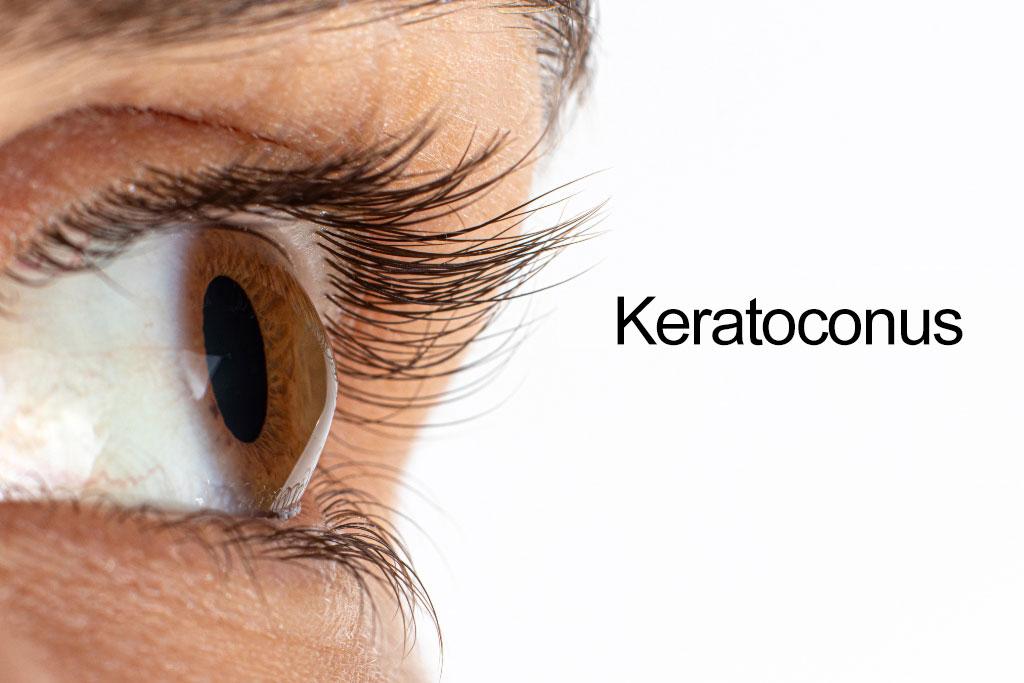This is the reality for many individuals living with keratoconus, a progressive eye disease that can severely impact vision if left untreated.
While it affects roughly 1 in every 2,000 people, keratoconus is often underdiagnosed, leading to delayed intervention and potential vision loss.
Understanding Keratoconus
So, what is keratoconus? This condition occurs when the cornea, the clear front surface of your eye, gradually thins and bulges outward into a cone-like shape.
This abnormal curvature disrupts the way light focuses on the retina, the light-sensitive tissue at the back of your eye, leading to a range of visual disturbances.
The altered corneal shape directly impacts vision in several ways:
- Irregular astigmatism: The uneven curvature of the cornea causes light to focus at multiple points instead of a single sharp point, resulting in blurry and distorted vision at both near and far distances.
- Blurred or distorted vision: Straight lines may appear wavy or bent, and overall clarity is reduced.
- Increased sensitivity to light and glare: The irregular corneal surface can scatter light, making bright lights and glare particularly bothersome, especially at night.
The exact keratoconus symptoms and causes are not fully understood, but several factors are believed to play a significant role:
- Genetic predisposition: Keratoconus often runs in families, suggesting a genetic link. If you have a family history of the condition, your risk is higher.
- Chronic eye rubbing: Vigorous and frequent eye rubbing, whether due to allergies or habit, can weaken the corneal tissue and contribute to its thinning and bulging.
- Underlying conditions: Certain medical conditions, such as allergic eye disease, eczema, asthma, and connective tissue disorders like Marfan syndrome and Ehlers-Danlos syndrome, have been associated with an increased risk of keratoconus.
- Environmental factors: While less clearly defined, environmental factors may also play a role in the development or progression of keratoconus.
How Keratoconus Leads to Vision Loss
The misshapen cornea in keratoconus prevents light from focusing correctly on the retina. The impact of corneal distortion on light focusing is the primary reason for the blurry and distorted vision experienced by individuals with the condition.
Keratoconus is a progressive disease, meaning it typically worsens over time. The progression can vary significantly from person to person. In mild early stages, vision changes may be subtle and correctable with glasses or soft contact lenses.
However, as the cornea continues to thin and bulge, the vision distortion becomes more pronounced, leading to severe advanced stages where conventional vision correction methods may no longer work.
Untreated keratoconus can lead to several complications that further compromise vision:
- Scarring of the cornea: In advanced stages, the apex of the corneal cone can become scarred, causing permanent visual impairment.
- Severe visual distortion: The irregular astigmatism and overall blurriness can become so significant that daily tasks like reading, driving, and recognizing faces become extremely challenging.
- Potential need for corneal transplant if untreated: In the most severe cases, when other treatment options are no longer working, a corneal transplant (keratoplasty) may be necessary to replace the damaged cornea with a healthy donor cornea.
Beyond the physical impact, keratoconus can also have a significant emotional impact. The progressive vision loss, particularly in young adults, can lead to frustration, anxiety, and a reduced quality of life.
Early Warning Signs to Watch For
Recognizing the early signs of keratoconus is important for timely intervention and preventing significant vision loss. Be vigilant for the following:
- Frequent changes in eyeglass or contact lens prescriptions: If your vision seems to be fluctuating rapidly and your current eyewear no longer provides clear vision, it could be an early indicator.
- Increased light sensitivity or glare: Experiencing discomfort in bright light or noticing halos around lights, especially at night, can be a sign of corneal irregularity.
- Difficulty with night driving: The increased glare and distorted vision can make night driving particularly challenging and potentially dangerous.
- Blurry or double vision in one eye: While blurry vision can have many causes, new onset blurry or double vision, especially if it seems more pronounced in one eye, should be investigated.
- Eye discomfort or headaches associated with vision strain: While not always specific to keratoconus, persistent eye strain and headaches, particularly when focusing, could be related to subtle changes in your cornea.
The importance of regular eye exams for early detection cannot be overstated. A comprehensive eye exam by a general eye doctor in Los Angeles or any other location can help identify early changes in the cornea that might not be noticeable to you. Individuals with a family history of keratoconus should be particularly diligent about regular check-ups.
Diagnosis: How Ophthalmologists Detect Keratoconus
If your eye doctor suspects keratoconus based on your symptoms and initial examination, they will likely perform specialized tests to confirm the diagnosis and assess the severity of the condition. These tests are typically conducted by an eye specialist for blurry vision.
- Comprehensive eye exam and corneal topography: This involves mapping the cornea’s curvature. A corneal topographer creates a detailed color-coded map of the corneal surface, revealing any irregularities or cone-like shapes characteristic of keratoconus.
- Pachymetry: This test measures the thickness of the cornea. Thinning of the cornea is a hallmark of keratoconus.
- Slit-lamp examination: Using a specialized microscope with a bright light, the ophthalmologist can examine the cornea in detail, looking for subtle signs of keratoconus, such as stromal thinning, Fleischer’s ring (a brownish-green ring around the base of the cone), and corneal striae (fine vertical lines in the deep stroma).
- Corneal tomography: This advanced imaging technique provides cross-sectional images of the cornea, allowing for a more detailed assessment of its structure and the detection of early corneal changes that might not be apparent with topography alone.
Preventing Vision Loss from Keratoconus
While there’s no definitive way to treat keratoconus, several strategies can help prevent or slow its progression and minimize vision loss.
- Early Detection Is Critical: As emphasized earlier, regular eye exams, especially if you have a family history of keratoconus or experience any of the early warning signs, are paramount. Early diagnosis allows for timely intervention and management.
- Avoid Eye Rubbing: Consciously avoid rubbing your eyes, even if they are itchy due to allergies. Gentle blinking or using lubricating eye drops is a safer alternative.
- Manage Allergies: If you suffer from seasonal or chronic allergies that cause itchy eyes, work with your doctor to develop a management plan, which may include antihistamines or other medications.
- Protective Eyewear: Wearing sunglasses that block harmful UV rays is always a good practice for overall eye health. While the direct link between UV exposure and keratoconus progression isn’t fully established, protecting your eyes is a wise precaution.
- Prompt Treatment: Once diagnosed, adhering to the treatment plan recommended by your ophthalmologist is necessary for managing the condition and preventing further vision deterioration.
Treatment Options for Keratoconus
The treatment approach for keratoconus depends on the stage and severity of the condition. A best keratoconus specialist in Los Angeles or any of the mentioned locations will tailor the treatment plan to your individual needs.
- Glasses or Soft Contact Lenses: In the very early stages, mild vision changes may be correctable with standard eyeglasses or soft contact lenses.
- Topography Guided PRK: The gold-standard treatment for this condition is Topography Guided PRK (TG-PRK); it’s a procedure where we map out your cornea and correct its shape using an advanced laser system.
- ICL Lenses: ICL lenses can provide excellent vision correction and comfort, especially for more advanced keratoconus.
- Corneal Cross-Linking (CXL): Also known as collagen crosslinking, this minimally invasive procedure strengthens the collagen fibers in the cornea, helping to stabilize its shape and halt or slow the progression of keratoconus. It is ideal for early and moderate stages of the disease.
- Intacs: Intacs implants are small, crescent-shaped plastic inserts that are surgically placed within the cornea to flatten the cone shape and improve vision. They are typically used for moderate keratoconus.
- Corneal Transplant: In severe cases with significant scarring or extreme thinning where other treatments may no longer work, a corneal transplant (keratoplasty) may be necessary to restore vision.
When seeking treatment, it’s necessary to find the best ophthalmologist for keratoconus or a top-rated eye surgeon in Los Angeles or your local area who has extensive experience in managing this complex condition.
Living Well with Keratoconus: Tips for Long-Term Eye Health
Living with keratoconus requires ongoing management and attention to your eye health. Key aspects include:
- Importance of routine monitoring with your ophthalmologist: Regular follow-up appointments are important to monitor the progression of the condition and adjust treatment as needed.
- Protective strategies: Continue to avoid eye trauma, consistently use prescribed lenses, and monitor for and manage allergy symptoms.
- Staying informed about new treatments and clinical trials: The field of keratoconus research is constantly evolving, so staying informed about new treatment options and potential clinical trials can be beneficial.
FAQs: Keratoconus and Vision Loss
Can keratoconus go away on its own?
No, keratoconus is a progressive condition that typically does not resolve spontaneously.
Is keratoconus hereditary?
There is a strong genetic component, and having a family history increases your risk.
How quickly does keratoconus progress?
The rate of progression varies significantly among individuals. It can be slow and stable for some, while others may experience more rapid changes.
Does corneal cross-linking cure keratoconus?
No, corneal cross-linking does not cure keratoconus, but it can halt or slow its progression.
When should I see an ophthalmologist for keratoconus?
If you experience any of the early warning signs or have a family history of the condition, it’s necessary to schedule a comprehensive eye exam with an ophthalmologist.
Can lifestyle changes help slow progression?
Avoiding eye rubbing is the most significant lifestyle change that can potentially impact the progression of keratoconus. Managing allergies to reduce the urge to rub is also important.
Conclusion
Keratoconus doesn’t have to lead to significant vision loss if it’s caught early and managed properly by a knowledgeable eye specialist for blurry vision or a best ophthalmologist for keratoconus in Los Angeles, Newport Beach, Beverly Hills, or Glendale.
Early detection through regular ophthalmic care, combined with patient awareness of the early signs of keratoconus and adherence to prescribed treatments like corneal cross-linking (CXL) or specialized contact lenses, are important for preserving your eyesight.
Don’t wait for your vision to worsen. If you are experiencing blurry or distorted vision, increased light sensitivity, or frequent changes in your eyeglass prescription, schedule a comprehensive eye exam today with Soroudi Advanced LASIK and Eye Centers!



